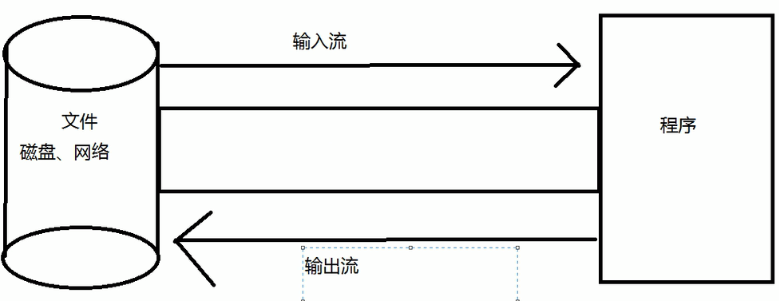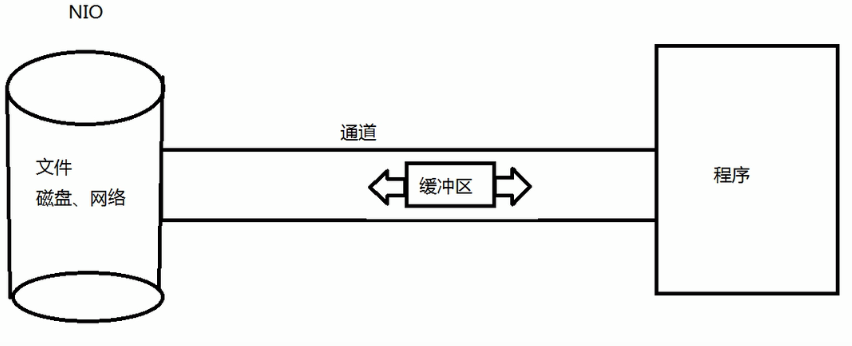1.Java NIO简介
Java NIO(New IO Non Blocking IO)是从Java1.4版本开始引入的一个新的IO AIPI,可以替代标准的Java IO API。NIO与原来的IO有同样的作用和目的,但是使用的方式完全不同,NIO支持面向缓冲区的、基于通道的IO操作。NIO将以更加高效的方式进行文件的读写操作。
三次握手才建立链接流通道
2.Java NIO与IO的主要区别

传统的IO流


3.Java 缓冲区(Buffer)和通道(Channel)
Java NIO系统的核心在于:通道(Channel)和缓冲区(Buffer)。通道表示打开到IO设备(例如:文件、套接字)的连接。若需要使用NIO系统,需要获取用于连接IO设备的通道以及用于容纳数据的缓冲区。然后操作缓冲区,对数据进行处理。
简而言之,Channel负责传输,Buffer负责存储。
缓冲区(Buffer)
缓冲区(Buffer):一个用于特定基本数据类型的容器。有java.nio包定义的,所有缓冲区都是Buffer抽象类的子类。
Java NIO中的Buffer主要用于与NIO通道进行交互,数据是从通道读入缓冲区,从缓冲区写入通道的。
一、缓冲区(Buffer):在Java NIO中负责数据的存取,缓冲区就是数组,用于存储不同数据类型的数据
根据数据类型不同(boolean除外),提供了相应类型的缓冲区
ByteBuffer
CharBuffer
shortBuffer
IntBuffer
LongBuffer
FloatBuffer
DoubleBuffer
上述缓冲区的管理方式几乎一致,通过allocate()获取缓冲区
二、缓冲区存取数据的两个核心方法: put():存入数据到缓冲区中 get():获取缓冲区中的数据
四、缓冲区的四个核心属性: capacity:容量,表示缓冲区中最大存储数据容量。一旦声明不能改变。
limit:界限,表示缓冲区中可以操作数据的大小。(limit 后数据不能进行读写)
position<=limit<=capacity
步骤一:开始是空的;

步骤二:put()数据模式;

步骤三:flip()读数据模式

String str = "abcde"; // 1.分配一个指定大小的缓冲区 ByteBuffer buf = ByteBuffer.allocate(1024); System.out.println("---------allocate()---------"); System.out.println(buf.position()); System.out.println(buf.limit()); System.out.println(buf.capacity());
结果为

// 2.利用put()存入数据到缓冲区中 buf.put(str.getBytes()); System.out.println("--------put()--------"); System.out.println(buf.position()); System.out.println(buf.limit()); System.out.println(buf.capacity());
结果为

// 3.切换成读取数据模式 buf.flip(); System.out.println("--------flip()--------"); System.out.println(buf.position()); System.out.println(buf.limit()); System.out.println(buf.capacity());
结果为

// 4.利用get()读取缓冲区中的数量 byte[] dst = new byte[buf.limit()]; buf.get(dst); System.out.println(new String(dst, 0, dst.length)); System.out.println("----------get()------------"); System.out.println(buf.position()); System.out.println(buf.limit()); System.out.println(buf.capacity());
结果为

// 5.rewind(): 可重复读 buf.rewind(); System.out.println("----------rewind()------------"); System.out.println(buf.position()); System.out.println(buf.limit()); System.out.println(buf.capacity());
结果为

// 6.clear() 清空缓冲区 buf.clear(); System.out.println("----------clear()------------"); System.out.println(buf.position()); System.out.println(buf.limit()); System.out.println(buf.capacity());
结果为

// 7.虽让缓冲区的数据的数据被清空,但是依然存在,只是处于“被遗忘”状态 System.out.println((char) buf.get());
结果为

mark:标记,表示记录当前position的位置,可以通过reset()恢复到mark的位置
0<=mark<=position<=limit<=capacity
String str = "abcde"; ByteBuffer buf = ByteBuffer.allocate(1024); buf.put(str.getBytes()); buf.flip(); byte[] dst = new byte[buf.limit()]; buf.get(dst, 0, 2); System.out.println(new String(dst, 0, 2)); System.out.println(buf.position()); // mark():标记 buf.mark(); buf.get(dst, 2, 2); System.out.println(new String(dst, 2, 2)); System.out.println(buf.position()); // reset:恢复到mark的位置 buf.reset(); System.out.println(buf.position()); //判断缓冲区中的数量 if(buf.hasRemaining()){ System.out.println(buf.remaining()); }

4.文件通道(FileChannel)
Java NIO中的FileChannel是一个连接到文件的通道。可以通过文件通道读写文件。
FileChannel无法设置为非阻塞模式,它总是运行在阻塞模式下。
打开FileChannel
在使用FileChannel之前,必须先打开它。但是,我们无法直接打开一个FileChannel,需要通过使用一个InputStream、OutputStream或RandomAccessFile来获取一个FileChannel实例。下面是通过RandomAccessFile打开FileChannel的示例:
1 |
RandomAccessFile aFile = new RandomAccessFile("data/nio-data.txt", "rw"); |
2 |
FileChannel inChannel = aFile.getChannel(); |
从FileChannel读取数据
调用多个read()方法之一从FileChannel中读取数据。如:
1 |
ByteBuffer buf = ByteBuffer.allocate(48); |
2 |
int bytesRead = inChannel.read(buf); |
首先,分配一个Buffer。从FileChannel中读取的数据将被读到Buffer中。
然后,调用FileChannel.read()方法。该方法将数据从FileChannel读取到Buffer中。read()方法返回的int值表示了有多少字节被读到了Buffer中。如果返回-1,表示到了文件末尾。
向FileChannel写数据
使用FileChannel.write()方法向FileChannel写数据,该方法的参数是一个Buffer。如:
01 |
String newData = "New String to write to file..." + System.currentTimeMillis(); |
02 |
03 |
ByteBuffer buf = ByteBuffer.allocate(48); |
04 |
buf.clear(); |
05 |
buf.put(newData.getBytes()); |
06 |
07 |
buf.flip(); |
08 |
09 |
while(buf.hasRemaining()) { |
10 |
channel.write(buf); |
11 |
} |
注意FileChannel.write()是在while循环中调用的。因为无法保证write()方法一次能向FileChannel写入多少字节,因此需要重复调用write()方法,直到Buffer中已经没有尚未写入通道的字节。
关闭FileChannel
用完FileChannel后必须将其关闭。如:
1 |
channel.close(); |
FileChannel的position方法
有时可能需要在FileChannel的某个特定位置进行数据的读/写操作。可以通过调用position()方法获取FileChannel的当前位置。
也可以通过调用position(long pos)方法设置FileChannel的当前位置。
这里有两个例子:
1 |
long pos = channel.position(); |
2 |
channel.position(pos +123); |
如果将位置设置在文件结束符之后,然后试图从文件通道中读取数据,读方法将返回-1 —— 文件结束标志。
如果将位置设置在文件结束符之后,然后向通道中写数据,文件将撑大到当前位置并写入数据。这可能导致“文件空洞”,磁盘上物理文件中写入的数据间有空隙。
FileChannel的size方法
FileChannel实例的size()方法将返回该实例所关联文件的大小。如:
1 |
long fileSize = channel.size(); |
FileChannel的truncate方法
可以使用FileChannel.truncate()方法截取一个文件。截取文件时,文件将中指定长度后面的部分将被删除。如:
1 |
channel.truncate(1024); |
这个例子截取文件的前1024个字节。
FileChannel的force方法
FileChannel.force()方法将通道里尚未写入磁盘的数据强制写到磁盘上。出于性能方面的考虑,操作系统会将数据缓存在内存中,所以无法保证写入到FileChannel里的数据一定会即时写到磁盘上。要保证这一点,需要调用force()方法。
force()方法有一个boolean类型的参数,指明是否同时将文件元数据(权限信息等)写到磁盘上。
下面的例子同时将文件数据和元数据强制写到磁盘上:
1 |
channel.force(true); |
5.NIO的非阻塞式网络通信
1.选择器
2.SocketChannel、ServerSocketChannel、DatagramChannel
6.通道(Pipe)
7.Java NIO(Path、Paths与Files)